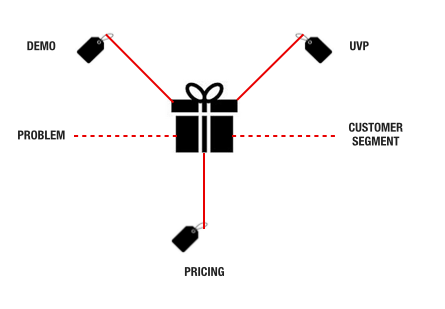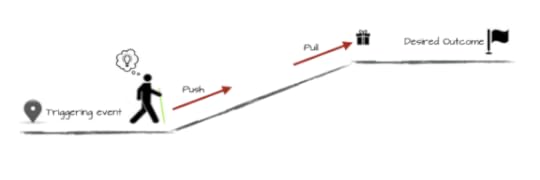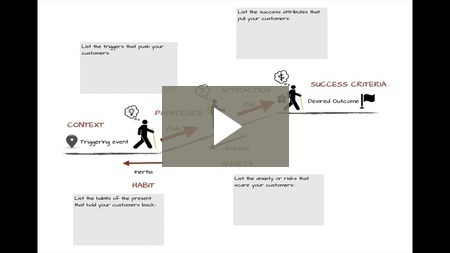The Science of How Customers Buy Anything
A basic tenet of running lean is validating a product or feature ideally without having to building it first. This makes complete sense when you look at every product or feature as it’s own customer factory.
The first battle isn’t fought on the ground but in the mind of the customer.
It isn’t fought with your built out solution but instead with an offer.
This is true not just at the earliest stages of defining your minimum viable product but at every stage of the product development cycle.
And here’s the key insight:
If you can’t get people inside your customer factory,
it doesn’t matter what’s inside.
The way you get them inside is with an offer.
What is an Offer
An offer is essentially a stand-in for your solution that validates sufficient customer pull for that solution.
The offer is basically made up of 3 elements:

Your unique value proposition which gets the customer’s attention
Your demo which shows them how you get them from point A (current reality) to point B (desired reality)
Your price or derivative currency of exchange which locks in commitment
Assembling a Compelling Offer
Before you can create a compelling offer, you have to gain a deep understanding of your customers and their problems.
You have to understand your customers better than they even understand themselves.
In my book, Running Lean, I detailed several customer interviewing (Problem Interviews) and observation techniques for doing this.
Since the book though, I’ve taken the work further in my workshops and bootcamps to make it more practicable – incorporating the customer factory work, customer journey maps, and the jobs-to-be-done framework.
Here’s an example of one of the deliverables from the early problem/solution fit stage:
It’s a marked up customer journey map that details your customer’s current reality workflow. We can then extract several layers of insights and inject our solution into this diagram that feed directly into making a more compelling offer.
I’m not going to walkthrough the detailed analysis steps today but I will walkthrough the resulting diagram that captures the job of your offer.
The job of the offer is acquiring customers i.e. turning unaware visitors into interested prospects.
The 3 elements I shared above are what go into assembling an offer but you additionally need to understand how customers buy in order to deliver your offer.
The Motivational Forces That Drive Customers to Buy
This diagram is best built up as a story.
So here we go…
Scene 1: The Push of the Trigger
Here you have a customer who is merrily going along his way until he has some kind of a triggering event.

This triggering event pushes the customer to seek some desired better outcome or make some change towards progress.
The bottom of the hill is his current reality and the top is the desired future reality he wants to achieve.
This triggerring event could be something explicit like having a new baby or it could be something more subtle like maybe having 2 of your friends purchase a new car in the last month.
These subtle triggering events can sometimes be hard to find, but if you look, they are almost always there.
A new baby is a significant life-changing event that pushes people to seek out all sorts of new desired outcomes or products. The more subtle car example trigger might not actively push a person to purchase a new car but it may all of sudden make him more receptive to car advertisements or promotions.
For this reason, some triggers are more *immediately* actionable than others, but knowing the trigger(s) can help uncover both active and passive leads.
Scene 2: The Pull of Your Offer
Understanding the key trigger and desired outcome establishes the situational context you need to best deliver your offer and the success criteria you need to communicate in your offer.

If you get these right and place your offer in the right context, it pulls customers towards your solution versus other alternatives. This is where your carefully crafted UVP, demo, and pricing come into play.
If you have a big enough audience and/or brand, it is often possible to make your offer the triggering event.
Think of an Apple product launch.
A less extreme example is an educational webinar that upsells a product.
Scene 3: Overcoming Inertia and Friction
But only communicating the positive attributes of your product is not enough. You also have to address two negative forces that hold the customer back.
The first one is friction caused by the anxiety or uncertainty of embracing something new.

Here, the customer visualizes taking this journey towards your solution which triggers them into contingency planning mode. These are usually mental roadblocks that keep people from taking a chance on a new solution: “What if I pick the wrong solution?”
Some typical remedies to overcome this friction are building in risk reversals into your offer. 30 day trials, no credit card required, money-back guarantees, social proof, are all examples of these.
The other negative force is caused by inertia which keeps people from trying something new.

You can think of this as the switching cost of moving from the current solution to your solution. These may be caused by actual switching costs like annual contracts or more cognitive switching costs ingrained in current behavior or habits.
A key insight here is realizing that even when delivering a potentially new disruptive solution, you don’t get to recreate the customer’s workflow from scratch.
When Steve Jobs introduced the iPad, he didn’t tell us 10 new things we could do with the iPad, but rather showed us 10 old things we could do with the iPad – only much better.
So the right approach here isn’t redrawing the workflow or ignoring this inertia, but making the transition to your product as seamless as possible.
Note: You can see the solution injection (blue box) in the customer journey map above with an appreciation for the customer’s existing workflow.
I will also add that not all friction and inertia is bad. I often use some friction and inertia as a qualifying criteria for identifying my best early adopters.
Your early adopters should have above average push and pull to overcome some of these negative forces.
But make sure you focus on the right force:

Here is the completed diagram with some additional annotation.

This diagram is what I use in my work with entrepreneurs. After all the interviews, observations, and analysis, this is the macro level view that gets us talking about how best to craft and deliver a compelling offer.
Remember this is a journey that happens inside your customer’s mind which is why I show thought bubbles in the pictures above. The end result isn’t always a sale but commitment that gets your closer to turning that unaware visitor into a happy customer.
I’d like to acknowledge 2 sources of inspiration in the creation of this diagram:
The Forces Diagram by Bob Moesta and Chris Spiek from the Jobs-to-be-done framework
Marketing Experiments’ Conversion Sequence Formula:
C = 4m + 3v + 2(i-f) – 2a ©
Additional Resources

When you become a Practice Trumps Theory member (it’s free), you’ll get access to a more in-depth 10 minute video lecture on the “Physics of Customer Acquisition” from my Customer Factory Blueprint bootcamp program and a PDF worksheet for creating your own forces diagram.












